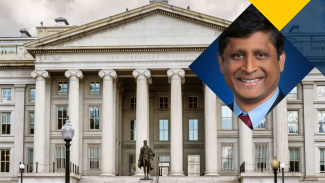Michigan Ross Professor Explores Warning Signs in Banking Industry

Banks reporting high profits in good times could be taking greater risks with their portfolios that lead to bigger trouble in a future downturn, according to a study co-authored by Amiyatosh Purnanandam, professor of finance at the Ross School of Business.
Judging banks’ risks by those reported profits, the researchers say, could be a simple, effective complement to other tools used by regulators assessing the health of financial institutions.
The authors used data from various financial crises, including those roiling the savings and loan industry in the late 1980s, the overall financial system in 2007-10 and regional banks earlier this year. They also examined the Russian debt crisis of 1998 and European sovereign debt crisis of 2008-11.
For each, they computed a bank’s return on “bad days” of the crisis as a measure of its tail risk—the extent of loss a bank experiences from a sudden, extreme negative event—and related it to the bank’s profitability a year before the crisis. They found banks with higher return on investment a year before the crisis performed much worse during the crisis.
Put simply, more profitable banks in good times had higher tail risk that materialized in bad times.
It’s a tempting approach, at least as long as the good times roll: Banks make a lot of return and generate a lot of profits that get distributed to their managers and shareholders. But the authors say those banks hold riskier assets and fund them with a lot of leverage to boost their return on equity, so when the party’s over, the banks’ performance is much worse.
The researchers say the proximate cause of every crisis often does a good job in explaining a bank’s poor performance during that specific episode, but focusing on the return on equity serves as an effective predictor across all the crises they examined.
“Overall, our message is to go after the deeper incentives behind risk-taking in banking and not only its proximate cause,” said Amiyatosh Purnanandam, co-author and finance professor at U-M’s Ross School of Business. “Higher equity capital requirements and a closer monitoring of very profitable banks in good times can be useful supervisory tools.”
Purnanandam says going deeper is important because too often regulators and policymakers are “fighting the last war” when they come up with a series of new regulations to fix the problems associated with a specific crisis. The next crisis, he says, “originates in some different corner of the financial system and we end up missing it.”
For example, regulators made a good deal of progress in containing excessive risk-taking in the mortgage market after the global financial crisis. But the recent collapse of Silicon Valley Bank came from excessive interest rate risk and reliance on uninsured deposits.
The key idea of their study, Purnandam and his colleagues say, is to go back to the first principles of risk-return tradeoff and propose an approach that is simpler and less vulnerable to manipulation. For instance, the study notes underreporting risk could only be achieved by underreporting profits, which would inhibit the ability to distribute returns to expectant managers and shareholders.
“No one measure is perfect,” he said. “We do not claim that our measure is ‘the only measure’ or ‘the perfect measure’ to detect risk. But we certainly hope that this is one simple and useful measure that the policymakers will pay attention to.”
Purnanandam’s co-authors are Ben Meiselman, a financial economist with the U.S. Department of Treasury who received his master’s and doctorate degrees from U-M; and Stefan Nagel, a finance professor at the University of Chicago’s Booth School of Business who previously taught at U-M’s Ross School.
In their paper, the authors say the findings, interpretations, and conclusions expressed in their paper do not necessarily reflect the views or positions of the Treasury Department.
This article was originally published in Michigan News.







